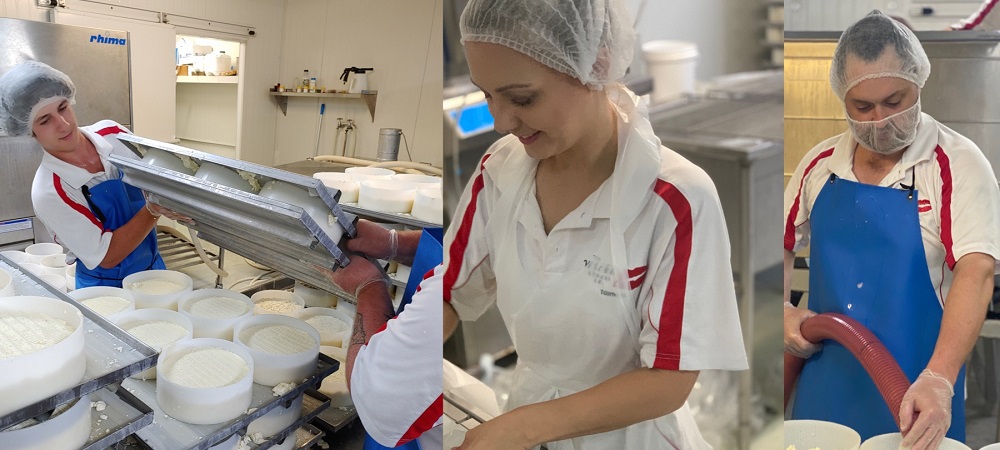From Thomastown to Your Table: The Excellence of Floridia Cheese Melbourne
From Thomastown to Your Table: The Excellence of Floridia Cheese Melbourne
Blog Article
Opening the Tricks of Artisanal Cheese Making: A Detailed Do It Yourself Overview
In the world of cooking workmanship, artisanal cheese making stands as a testament to the delicate equilibrium between tradition and development. Each action in the process, from choosing the ideal milk to developing aging strategies, holds within it a wealth of understanding gave via generations. As we begin on this trip to demystify the art of developing beautiful cheeses, we are confronted with a tapestry of tricks and abilities waiting to be deciphered. Join us as we discover the ins and outs of this ancient craft, where scientific research, art, and perseverance merge to create flavors that tantalize the senses.
Choosing the Right Milk
When embarking on the journey of artisanal cheese production, the choice of milk plays an important role in establishing the quality and attributes of the end product. The kind of milk chosen affects the flavor, structure, and overall profile of the cheese. Raw milk, straight from the pet, is favored by several artisanal cheesemakers as a result of its unique mix of enzymes, bacteria, and taste compounds. Nevertheless, using raw milk features regulations and risks, making sterilized milk a much safer alternative for novices.
When picking milk for cheese making, it is essential to think about the fat material. Greater fat web content in milk can cause a creamier and richer cheese, while lower fat material might bring about a drier and firmer appearance. Furthermore, the resource of the milk, whether from cows, goats, lamb, or buffalo, adds distinctive flavors and features to celebrity (Floridia Cheese Melbourne). Each sort of milk brings its own nuances, enabling a large range of cheese ranges to be crafted based upon the selected milk. Eventually, the choice of milk is a fundamental choice that sets the foundation for a successful artisanal cheese-making undertaking.
Culturing and Coagulating
To launch the cheese-making process, the essential actions of culturing and coagulating need to be meticulously carried out to change milk into curds and whey. The kind of society used can significantly impact the taste, structure, and ripening of the last cheese product.

The timing and temperature control during culturing and coagulation are crucial elements that influence the final outcome of the cheese. Appropriate implementation of these actions is vital to ensure the preferred texture, flavor, and consistency of the artisanal cheese being generated.
Draining Pipes and Pressing Curds
After the milk proteins have actually coagulated and the curds have actually been reduced to release whey, the next crucial action in artisanal cheese making includes draining pipes and pressing the curds to accomplish the wanted structure and consistency of the last cheese item. Draining is the process of separating the curds from the whey. This can be done by transferring the curds right into a cheesecloth-lined colander or mold and mildew and permitting the whey to drain pipes off normally. The moment for draining can differ relying on the kind of cheese being made and the wanted moisture web content.
Pressing helps expel any Recommended Reading type of continuing to be whey and compacts the curds to form a solid cheese wheel. Proper pressing and draining pipes are vital steps that substantially affect the quality and attributes of the artisanal cheese being created.
Aging and Flavoring Techniques
Carrying out careful aging and flavor strategies is essential in enhancing the depth and complexity of artisanal cheeses, raising their preference profiles to exquisite levels of refinement and refinement. Aging plays a crucial role in creating the distinct tastes and textures that distinguish artisanal cheeses. During the aging procedure, cheeses are stored in meticulously regulated environments where factors such as temperature level, air movement, and moisture are controlled to urge the growth of useful molds and bacteria. This controlled environment permits celebrity to mature gradually, creating abundant tastes and complex fragrances.
Flavoring strategies also add dramatically to the final preference of artisanal cheeses. Cheesemakers may pick to introduce extra tastes by incorporating ingredients such as natural herbs, spices, or perhaps fruits into the cheese during the manufacturing procedure. Additionally, some cheeses are cleaned or rubbed with various fluids, such as brine or alcohol, my link to enhance their flavors and appearances.
Wrapping and Saving Cheeses

Final Thought
In final thought, understanding the art of artisanal cheese making involves carefully selecting the best milk, complying with accurate culturing and coagulating procedures, draining pipes and pressing curds efficiently, and making use of different aging and flavoring methods. By adhering to these actions carefully and with focus to detail, you can develop your very own tasty and special cheeses in the house. Remember to wrap and store your cheeses correctly to guarantee optimum taste and appearance advancement. Pleased cheese making!
Each type of milk brings its very own subtleties, permitting for a broad array of cheese ranges to be crafted based on the picked milk.After the milk proteins have actually coagulated and the curds have actually been reduced to release whey, the following important step in artisanal cheese making includes draining pipes and pushing the curds to accomplish the wanted appearance and uniformity see this website of the final cheese product. A lot of cheeses should be wrapped in wax paper or cheese paper to permit them to take a breath while safeguarding them from drying out. For cheeses that require to continue aging, such as bloomy skins or washed skins, guarantee they are kept in a cool setting like a cheese cave or a fridge set to the proper temperature. By paying focus to the wrapping and storage space of artisanal cheeses, cheese makers and lovers can protect the stability of these specials and completely appreciate their intricate flavors.
Report this page